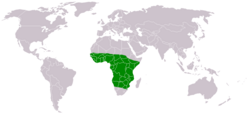Red-breasted shiny-headed
| Red-breasted shiny-headed | ||||||||||||
|---|---|---|---|---|---|---|---|---|---|---|---|---|

Red-breasted shining head ( Chalcomitra senegalensis ) |
||||||||||||
| Systematics | ||||||||||||
|
||||||||||||
| Scientific name | ||||||||||||
| Chalcomitra senegalensis | ||||||||||||
| ( Linnaeus , 1766) | ||||||||||||
| Subspecies | ||||||||||||
|
The red breast shining head ( Chalcomitra senegalensis , syn .: Nectarinia senegalensis ), also known as the natal shining head or the red throated nectar bird , is a nectar-eating passerine bird . The plumage of the male has an iridescent red patch on the chest and a shiny green crown, hence the name red-breasted shiny head.
features
Red breast shining heads are up to 15 cm long and have wingspans between 25 and 30 cm. Their weight is 10–11 g. Their sharp calls can often be heard for hours. The long beak is curved downwards and pointed at the end. The male has iridescent and conspicuous plumage during the breeding and courtship season . The basic color is black, the chest is bright red and the crown and throat are green. The shimmering colors can be explained by the special structure of the feathers , which allows the feathers to lively reflect certain wavelengths . The plain dress is much more matt. The female is colored dark brown above and mottled light brown below.
Way of life
The shining red breasts are very lively and almost always in motion. Mostly they stay in the treetops, but they also come down to the ground more often. The males are more aggressive, less sociable and call out more often than their female counterparts. You can often see males following each other over long distances. The shyness of people is not very pronounced, so the shiny heads let people up to a few meters.
distribution
They live all over sub- Saharan Africa , with the exception of parts of South Africa and Namibia . Their habitat are open forests and savannas , river banks and tropical regions . The bird species is currently not threatened.
Reproduction
The breeding season of the red-breasted shiners lasts from August to March. After the female has built a pot-shaped nest of leaves, hay, spider webs and other plant parts at a height of 2–10 m on a branch tip within a week , she lays two white or light gray oval eggs with olive-gray spots. The incubation period is 14–15 days, the nestling period a further 16–19 days.
food
In addition to insects, caterpillars, grasshoppers and spiders, the red breasted glossy head eats a lot of nectar; especially leonotis , coral and aloe blossoms . To do this, they use their pointed beak to pierce thick flower covers. Then the juice is sucked in with the long, tubular tongue.
literature
- Gottfried Mauersberger : Birds (= Rororo animal world. The Urania animal kingdom in 18 volumes. Vol. 6). Volume 3. Rowohlt Taschenbuch-Verlag, Reinbek near Hamburg 1974, ISBN 3-499-28006-X , pp. 452–453.
Individual evidence
- ↑ Gottfried Mauersberger: Birds. Volume 3. 1974, p. 452.
Web links
- Videos, photos and sound recordings on Chalcomitra senegalensis in the Internet Bird Collection
- Entry on the Avibase
- Chalcomitra senegalensis inthe IUCN 2013 Red List of Threatened Species . Listed by: BirdLife International, 2012. Retrieved January 29, 2014.
